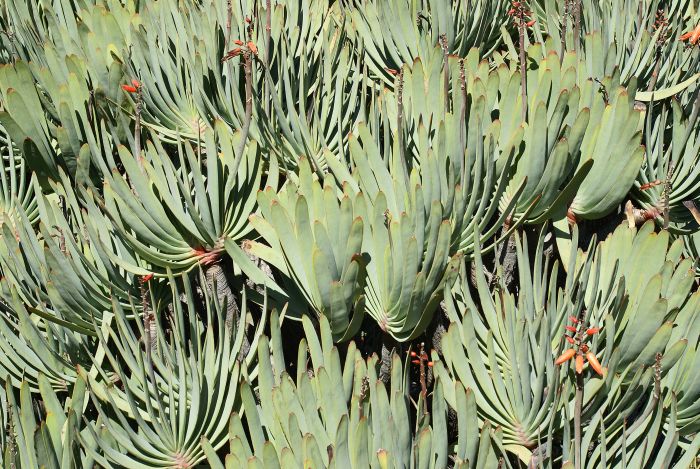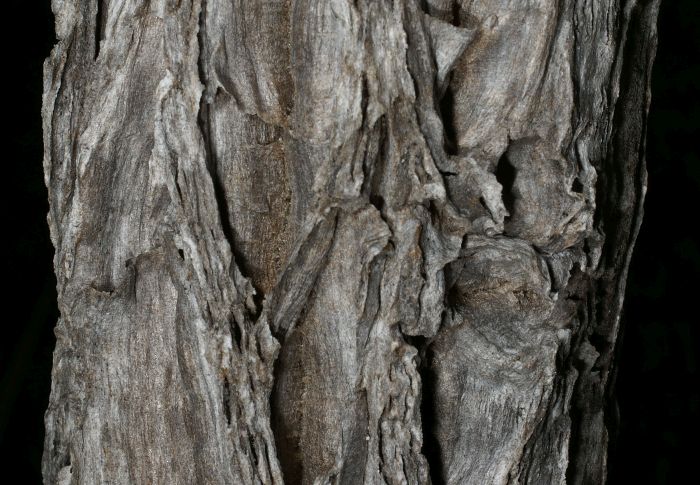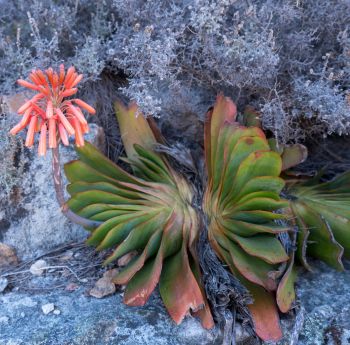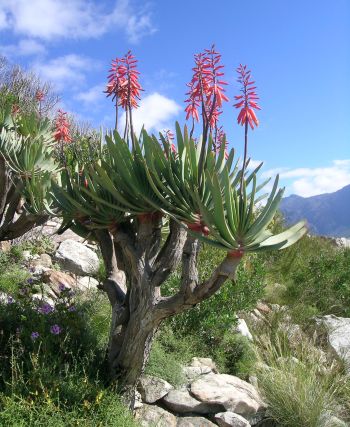Kumara genus
Kumara Medik.
Family: Asphodelaceae
Common names: fan aloes (Eng.); waaieraalwyne (Afr.)
Introduction
With their strap-like leaves arranged in the shape of a fan—hence the common names applied to the two species included in Kumara—these plants are unique among the southern African aloes. Only in some miniature Malagasy aloes, such as Aloe calcairophylla, are leaves arranged in a single row encountered. Moreover, the leaves of the two Kumara species also lack the protective marginal teeth, so common among aloes. When in flower, the fan aloes, especially Kumara plicatilis, form spectacular scenes against the backdrop of their rugged mountainous habitat in fynbos vegetation, to which they are confined.

Fig. 1: Striking mass of fan-like rosettes of Kumara plicatilis. Photo: A.W. Klopper
Description
Description
Kumara is a genus of two species that were previously included in the genus Aloe. However, evidence from molecular research on generic-level relationships among the alooids, has resulted in Aloe being split into several segregate genera: Aloe (true aloes), Aloiampelos (rambling aloes), Aloidendron (tree aloes), Aristaloe (awn-leaf aloe), Gonialoe (variegated or kanniedood aloes), and Kumara (fan aloes). In terms of number of included species, Kumara, with only two, is the second smallest of the alooid genera; at the moment Aristaloe consists of a single species, A. aristata. Kumara was described by Friedrich Kasimir Medikus (1736–1808) in 1786. To this day, the origin or meaning of the genus name remains uncertain.
Fan aloe plants are either low-growing and stemless with an underground rootstock and strong roots as in K. haemanthifolia, or are trees with dichotomously branched (forked) stems and branches, with the fan-shaped rosettes carried at the tips of the branches as in K. plicatilis. Unlike many true aloes, the old, dry leaves of fan aloes are not persistent, thus yielding naked stems and branches. However, the stems and branches are covered in a distinctive thick, corky bark.

Fig. 2: Stems and branches of Kumara plicatilis are covered in a thick, corky bark that protects it against fire damage. Photo: A.W. Klopper
In general, the two species of Kumara are characterised by their succulent, strap-shaped leaves, which also resemble a cow’s tongue, hence the lesser used common name, cow’s tongue aloes. The leaves are carried in a fan-like rosette, not unlike the leaf arrangement found in some gasterias, commonly called beestong (ox tongue). While the leaf margins are mostly unarmed, they can sometimes have minute teeth towards and at the abruptly rounded tip of the leaf. Both species have prominent fibres in their leaves, which is an unusual character amongst the aloes. The leaf sap of the fan aloes is not bitter, as in most other aloes.

Fig. 3: Strap-shaped leaves are carried in a fan-like rosette. Fibres are visible in the centre image. Photo: Kumara haemanthifolia (left and centre) by E.J. van Jaarsveld; Kumara plicatilis (right), by A.W. Klopper
Inflorescences of the fan aloes are erect, unbranched, and normally only one is carried per leaf rosette. The flower clusters (racemes) are either dense and head-shaped with orange to scarlet flowers as in K. haemanthifolia, or lax and cone-shaped with scarlet flowers as in K. plicatilis. The flowers are generally pencil- to cigar-shaped. Flower buds are erectly to horizontally disposed, while the open flowers are pendent.

Fig. 4: Flower clusters of Kumara haemanthifolia (left) are head-shaped and dense, while those of Kumara plicatilis (right) are conical and lax. Photos: Kumara haemanthifolia by P. Thompson; Kumara plicatilis by N.R. Crouch
The 3-capsuled fruits dry out and split open at maturity to release the dark brown to black seeds. The seeds have narrow wings and are dispersed by wind. Both fan aloes are slow-growing and long-lived. Large specimens found in their fire-prone, fynbos habitats are several decades old.
Conservation Status
Status
Both species of Kumara are assessed as Least Concern (LC) in the Red List of South African Plants. Their specific habitat requirements and restricted natural distribution ranges, often in inaccessible mountainous terrain, have served to protect these species, at least to some extent. Both could potentially be threatened by encroaching alien invasive plants and expanding silviculture. However, this is currently not impacting on the conservation status of these aloes, but populations should be monitored and managed properly.
Distribution and habitat
Distribution description
The genus Kumara is comprised of two species: K. haemanthifolia and K. plicatilis. Both are endemic (restricted) to the mountainous areas of the Western Cape, South Africa. Fan aloes grow on steep, rocky slopes in fynbos vegetation, often in inaccessible places. Both species have a very restricted distribution on sandstone in a region that receives high winter rainfall.

Fig. 5: Fan aloes often grow on inaccessible, steep, rocky slopes in fynbos vegetation. Photo: P. Thompson
Ecology
Ecology
The fan aloes are relatively protected in their rocky mountain and cliff habitats against most herbivores, but can be impacted by fires that often rage in fynbos. Plants are protected against severe fire damage, not only by the rocky habitat, but also by the succulent nature of the leaves of both fan aloes, the corky bark on the stem of Kumara plicatilis, and the strong underground rootstock of K. haemanthifolia. Flowers, fruit, and leaves of these aloes are occasionally eaten by baboons. Rock hyrax can cause damage to K. plicatilis, especially during drought, by debarking and eating the stems.
Sunbirds and several insects visit and pollinate the flowers in their quest for pollen and nectar. It was shown that insects (mostly bees and beetles) play the largest role in pollination of K. plicatilis, while Malachite Sunbirds (Nectarinia famosa) and perhaps Cape Sugarbirds (Promerops cafer) are its most important avian pollination agents. The seed of these aloes have narrow wings, which aid in easy dispersal by the wind, and seedling recruitment is said to be very successful.
Uses
Use
Kumara plicatilis is very popular as a garden subject in parts of the world with a Mediterranean climate (mild, wet winters and dry, warm to hot summers) and in, for example, California, along the west coast of the USA, a substantial number of plants are offered for sale in the nursery trade. This material seemingly has been produced from stock exported from South Africa many decades, or even centuries ago.

Fig. 6: The slow-growing Kumara plicatilis is suitable as a container plant and will flower while still small. Photo: G.F. Smith, taken in the Huntington Botanical Gardens, California, USA.
Growing Kumara genus
Grow
Kumara haemanthifolia has very specific habitat requirements, which are not easily duplicated in cultivation, especially in summer-rainfall regions and places that experience a severe, continental-type climate. To successfully grow plants well away from their natural habitats, plants must be kept under the protection of glass, more so if temperatures regularly drop below 0°C.
In contrast, Kumara plicatilis is fairly easily cultivated when given the correct growing conditions. It requires well-drained soil and protection from harsh sun. Especially in summer rainfall gardens, special care should be taken to prevent over-watering, specifically in summer, and to provide protection from severe frost in winter. It is easily grown from seed, but is very slow growing. Therefore, propagation by branch cuttings is preferred. In nature, roots easily form along fallen stems where sufficient soil is present, and this characteristic of the plant is used to the benefit of gardeners. This aloe can be used as a focal point in a bed, but is also suitable as a container plant because of its slow growth rate. Even small branches that have rooted successfully will flower in a pot.
Species

Plants form dense groups of stemless rosettes of up to 0.7 m high. Leaves are strap-shaped with a rounded tip, arranged in a fan, up to 200 mm long, and ± 80 mm wide, with reddish, mostly toothless margins. Orange to scarlet flowers (± 38 mm long) are borne in unbranched inflorescences consisting of head-shaped, rather dense racemes (flower heads) in spring, between September and December, but mainly in October. This species is restricted to high mountain peaks from Stellenbosch to near Ceres, Western Cape, South Africa. It grows on almost inaccessible Table Mountain Sandstone cliffs in the Cape Fold Belt Mountains, in very wet, grassy and rocky places on south- and southeast-facing slopes. The habitat is not warm in summer, but above the snowline in winter and experiences high winter rainfall and significant mist.

Plants form tall shrubs or small to medium-sized trees with a naked stem of 3–5 m high, which is dichotomously branched (forked) and rebranched. Leaves are strap-shaped with a rounded tip, arranged in a fan, ± 300 mm long, and ± 40 mm wide, with a narrow mostly toothless margin, which does not differ significantly in colour from the rest of the leaf. The leaf sap is clear, but becomes pale yellow and wax-like when dry. Scarlet flowers (up to 55 mm long) are borne in unbranched inflorescences consisting of cone-shaped, lax racemes (flower clusters) in late winter and spring (August to October). This species is restricted to mountainous parts from Franschhoek to Elandskloof, Western Cape, South Africa. It grows on Table Mountain Sandstone substrates in mountainous areas of very high winter rainfall, among Fynbos Heathland, on steep southwest-facing slopes in rocky areas.
References
- Cousins, S.R. 2010. Fanfare in the fynbos. Veld & Flora 96(4): 164–165.
- Cousins, S.R., Witkowski, E.T.F. & Pfab, M.F. 2014. Elucidating patterns in the population size structure and density of Aloe plicatilis, a tree aloe endemic to the Cape fynbos, South Africa. South African Journal of Botany 90: 20–36.
- Cousins, S.R., Witkowski, E.T.F., Pfab, M.F., Riddles, L.R. & Mycock, D.J. 2013. Reproductive ecology of Aloe plicatilis, a fynbos tree aloe endemic to the Cape Winelands, South Africa. South African Journal of Botany 87: 52–65.
- Glen, H.F. & Condy G.S. 1988. Aloe plicatilis. The Flowering Plants of Africa 50(1): t.1972.
- Glen, H.F., Craib, C. & Condy G.S. 1993. Aloe haemanthifolia. The Flowering Plants of Africa 52(2): t.2063.
- Grace, O.M., Klopper, R., Smith, G.F., Crouch, N.R., Figueiredo, E., RØnsted, N.E. & Van Wyk, A.E. 2013. A revised generic classification for Aloe (Xanthorrhoeaceae subfam. Asphodeloideae). Phytotaxa 76,1: 7–14.
- Manning, J.C. et al. 2014. A molecular phylogeny and generic classification of Asphodelaceae subfamily Alooideae: A final resolution of the prickly issue of polyphyly in the alooids? Systematic Botany 39: 55–74. http://dx.doi.org/10.1600/036364414X678044
- Red List of South African plants. 2021. Genus Kumara. http://redlist.sanbi.org/genus.php?genus=7077. Accessed on 5 August 2021.
- Smith, G.F. & Van Wyk, B. 2008. Aloes in southern Africa. Struik, Cape Town.
Credits
Ronell R. Klopper,
Foundational Biodiversity Sciences, National Herbarium, SANBI
and Gideon F. Smith,
Department of Botany, Nelson Mandela University
October 2021
Acknowledgments: The authors thank Stephen Cousins, Neil R. Crouch, Arrie W. Klopper, Peter Thompson, and Ernst J. van Jaarsveld for supplying the images, as follows:
Stephen R. Cousins: K. plicatilis (plant)
Neil R. Crouch: K. plicatilis (inflorescence)
Arrie W. Klopper: K. plicatilis (rosettes, bark, leaves)
Peter Thompson: Habitat, K. haemanthifolia (inflorescence, plant)
Ernst J. van Jaarsveld: K. haemanthifolia (rosettes, leaf showing fibres)
Other image credits:
Gideon F. Smith: K. plicatilis (potted plant)
Plant Attributes:
Plant Type:
SA Distribution:
Soil type:
Flowering season:
PH:
Flower colour:
Aspect:
Gardening skill:
Special Features:
Horticultural zones






Rate this article
Article well written and informative
Rate this plant
Is this an interesting plant?
Login to add your Comment
Back to topNot registered yet? Click here to register.